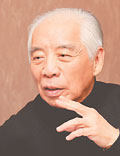It took 50 years for 'Eggshell' to hatch
Updated: 2008-01-29 07:29
For a younger generation that is as futuristic as the National Grand Theater, the composer of the Red Women Detachment is typically a reminder of a period when people had few other choices but to watch "model plays".
 Wu Zuqiang |
But it might come as a surprise to them that the "red artist", 81-year-old Wu Zuqiang, is the "invisible hand" behind the building of the avant-garde theater west of Tian'anmen Square.
For Wu, the theater - dubbed Eggshell - is akin to a baby which took half a century between conception and delivery. And the difficult process of coming into being was intertwined with the ups and downs in his life and the cultural scene.
"It was Premier Zhou Enlai who chose the location for the theater in 1958," he said, adding that the plan to build a national theater can be traced back to the early 1950s. Under an agreement, the former Soviet Union promised to provide funding and expertise.
The design was unveiled in 1958, and the Russian architectural style was modeled on the neighboring National Museum. The theater was intended to be the biggest in the world - even bigger than the one in Moscow.
But relations between the two countries began to cool off and the Great Leap Forward (1958-60) was launched. The theater remained on paper.
Wu expected to see his music played at the theater - of the 8,000-odd young people that China sent to study in the former Soviet Union between 1955 and 1965, he was the only one to major in music composition.
After five years at the Tchaikovsky Music Conservatory in Moscow, he graduated with honors and his symphony, My Beloved Motherland, was performed at the graduation ceremony.
But what awaited Wu in his motherland was political upheaval, and the composer who later created the masterpieces of "red art" suffered because of his overseas education.
He became a farmer in the suburb of the capital, where the music that he learned could not be played. Only after a day's labor in the wheat field, in the darkness of the night, could he replay in his mind the soothing flows of music and life from his carefree days at the conservatory.
He dreamed most about the theater. In his opinion, the Theater of Dionysus in the Acropolis of Greece and the La Scala Theater in Milan became symbols of cultural renaissance because they provided a platform for diverse arts, and many artists from far away traveled to perform there.
"If there were a theater, it would be easy for people to know about the diverse cultures that crisscross the globe," he said. "They would be more tolerant of other cultures, ideas and ideals.
"It is only through an expanding tolerance for different cultures and ways of life that a nation can step up its exchanges with the rest of the world and embark upon a cultural renaissance."
As the director of the theater's artistic committee, Wu is now more focused on the management of the cultural showpiece. "I don't worry about the artists - the best ones will come. I am concerned whether we are able to run this theater effectively.
"No one here has any experience in managing such a giant art institution. We must send people to study and to work at foreign theaters."
He also hopes the public gives the theater some time to adapt to its role.
"The theater had a much more difficult process of coming into being than an expressway or a government building. It took 50 years. It is worth being cherished, and it needs time to grow up," he said.
|
|
|
||
|
||
|
|
|
|